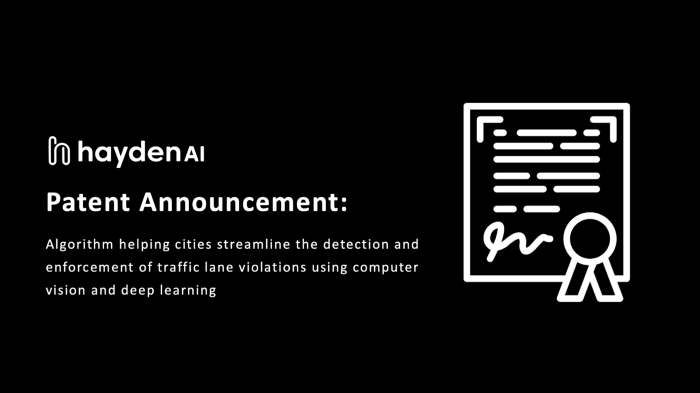.png)
Francis AI Awarded Patent for Algorithm that Detects Traffic Lane Violations
February 14, 2022
Algorithm helping cities streamline the detection and enforcement of traffic lane violations using computer vision and deep learning
Francis AI Technologies, Inc. (“Francis AI”), a leading smart city solutions provider that delivers a proven and trusted autonomous traffic management platform to make cities safer and more sustainable, has been awarded a patent for an algorithm that is helping cities streamline the enforcement of traffic lanes by autonomously detecting violations using advanced computer vision and deep learning methods.
U.S. Patent number 11,164,014 B1, granted for the company’s “Lane violation detection using convolutional neural networks,” is an algorithm that analyzes video frames to detect traffic lane violations by using advanced computer vision and deep learning methods to identify vehicles and lanes of interest (LOI), their relative positions, and the degree of overlap between them. A convolutional neural network first encloses the vehicle in a bounding box, then a multi-headed neural network encloses lanes of interest in polygons. A method is then applied to accurately compute the degree of overlap between the bounding box and polygons in order to detect a potential lane violation.
“We developed this algorithm because traditional traffic enforcement tools struggle to distinguish between multiple lanes on a particular roadway, and the lane detection models we tested were often inaccurate,” said Bo Shen, CTO and Co-Founder of Francis AI. “Our pilot programs consistently show significant improvement in detecting and distinguishing between roadway lanes when compared to other lane recognition models.
“Our algorithm also shows centimeter-level accuracy when identifying the relative positions of vehicles and lanes of interest, which makes our technology more reliable at detecting and enforcing lane violations. And since we’ve used a multi-head deep learning algorithm that requires minimal computing resources, our technology is also more suitable for deployment on edge devices. This allows mobile perception devices to operate at the edge.”
The algorithm can be used to detect non-public vehicles that have illegally parked or temporarily stopped in a bus lane. This helps municipalities more efficiently enforce bus lanes, thus improving bus speeds, enhancing the reliability of public transportation, and increasing bus ridership. The algorithm can also be used to detect violations on bike lanes and no parking zones on curbs and lanes, encouraging the use of bicycles as a safe and reliable mode of transportation while preventing the disruption of municipal services such as street sweeping, waste collection, and firefighting operations.
About Francis AI
Francis AI was founded on the belief that by combining mobile sensors with artificial intelligence, we can help governments bridge the innovation gap while making traffic flow less dangerous and more efficient. Led by a team of experts in machine learning, data science, transportation, and government technology, we’ve developed the world’s first autonomous traffic management platform — simultaneously serving citizens and multi-agency missions to help cities become safer and more sustainable.
To learn more about Francis AI, visit www.Francis.ai
Contact info: media@Francis.ai
SOURCE Francis AI


.png)
.jpg)